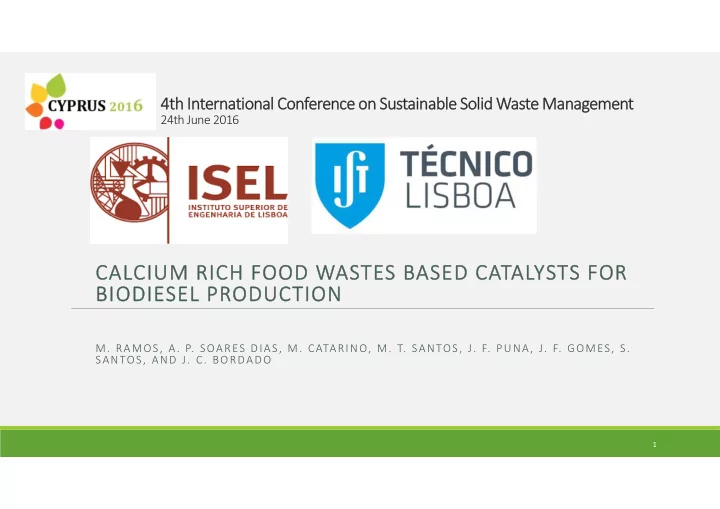

4th 4th In Internatio ional Conf nfer erence ence on on Sus Sustainab ainable Sol Solid Wa Waste Ma Manag nagemen ment 24th June 2016 CAL CALCIUM RICH RICH FOOD FOOD WA WASTES BA BASED CA CATALYSTS STS FOR FOR BI BIODI ODIESEL SEL PR PRODUC ODUCTI TION ON M. RAMOS, A. P. SOARES DIAS, M. CATARINO, M. T. SANTOS, J. F. PUNA, J. F. GOMES, S. SANTOS, AND J. C. BORDADO 1
Contents Objective Biodiesel Experimental Procedure Results Conclusions Future Work 2
Objective: Biodiesel (FAME) production using solid and liquid wastes from food industry in Portugal. Waste Ca rich shells 3
Biodiesel First generation biodiesel (FAME) is pointed out as a feasible substitute of fossil diesel 4
Biodiesel can be produced from vegetable oils (edible or non edible), animal fats or even recycled greases from food industry, restaurants or domestic waste. In 2010 the amount of waste frying oils (WFO) manufactured in Portugal was 43,000 - 65,000 t. Lard Vegetable oil WFO Natural calcium sources from wastes can be used to prepare CaO catalyst for biodiesel production. In last year in Portugal were captured 749 t of crustacean, 19,172 t molluscs. Egg production for consumption 106,784 t. 5
Cheap raw materials like waste frying oils and animal fats will allow to reduces the biodiesel production costs Basic catalysts will be deactivated by neutralization and soap formation 6
Experimental Procedure Preparation of the catalysts Washing and drying at 120ºC of the as o received shells Crushing and sieving o Calcination in a muffle at 800ºC (3h) o The calcination temperature was selected from the thermal degradation profile of the raw shells obtained by thermogravimetry under air flow CaCO 3 CaO+CO 2 for T>800ºC under air 7
Transesterification and Catalyst Separation Process The catalyst separation from the reaction products Biodiesel reaction (100 g Biodiesel oil; 5 % w cat /w oil ; methanol reflux Glycerol temperature; molar racio Reaction methanol/oil=12; 2.5 h) products with catalyst 8
Biodiesel Purification Process 9
Results Catalyst Characterization Figure 2 - Shows the DTA profiles of 9 raw Ca wastes as fresh catalysts. Figure 1 - XRD patterns of fresh catalysts prepared by calcination at 800ºC. Lime: CaO; Portlandite: Ca(OH) 2 ; Calcite: CaCO 3. . 10
Biodiesel Characterization Table 1 – FAME yield using Waste Frying Oil (WFO) and WFO/Soybean (Soy) mixtures assessed by thermogravimetry (under air, 30 ºC/min). FAME Catalyst Raw ‐ material yield (%) Scallop 90.9 50%WFO_50%Soy Shellmix 82.6 Shellmix 75%WFO_25%Soy 82.0 Shellmix batch#1 62.5 WFO Shellmix Figure 3 – FAME yield, assessed by thermogravimetry, obtained for soybean oil batch#2 88.4 using the lime catalysts from Ca rich alimentary wastes (5 % w cat /w oil ; molar racio methanol/oil=12; 2.5 h). 11
Conclusions In standard conditions high FAME yields were obtained for all the tested catalyst whith alimentary refined soybean oil. When used pure WFO a decline of the catalyst activity was observed, FAME yield decreased and was observed soap formation, this is due to WFO acidity be quite higher 2mg KOH/g oil. WFO can be processed mixed with neutral oil without significant loss of the catalytic performance. These natural catalysts are very active and suitable for biodiesel production through the transesterification process. 12
Future Work Optimization of reactions; Stability study of catalytic process; Study of the kinetics catalytic reaction; Study catalysts in nanostructured form. 13
Acknowledgement We want to thank the FCT – Fundação para a Ciência e Tecnologia, Lisboa, Portugal, for funding project PTDC/EMS-ENE/4865/2014, to Instituto Superior Técnico (IST), Laboratory of Tecnology ADEQ and Centro de Estudos de Engenharia Química from ISEL, for laboratory and equipment utilization. 14
References [1] Girish, N., Niju, S.P., Begum, K. M. M. S., Anantharaman, N.: Utilization of a cost effective solid catalyst derived from natural white bivalve clam shell for transesterification of waste frying oil. Fuel 111 (2013), 653-658. [2] Kiss, A. A., Omota, F., Dimian, A. C., Rothenberg, G.: The heterogeneous advantage: biodiesel by catalytic reactive distillation. Topics in Catalysis (2006). doi: 10.1007/s11244-006-0116-4 [3] A.P.A.: Óleos Alimentares Usados. (2010) [4] Direção - Geral de Energia e Geologia: Energia em Portugal 2014. (2016) [5] Puna J.F., Gomes J.F., Correia M. J., Dias, A.P., Bordado, J.C., Advances on the development of novel heterogeneous catalysts for transesterification of triglycerides in biodiesel, Fuel, 89 (2010) 3602-3606. [6] Kouzu M., Hidaka J., Transesterification of vegetable oil into biodiesel catalyzed by CaO: A review, Fuel, 93 (2012), 1-12. [7] Avhad, M., Marchetti, J., A review on recent advancement in catalytic materials for biodiesel production, Renewable and Sustainable Energy Reviews 50 (2015), 696-718. 15
Thank You For Your Attention 16
Recommend
More recommend